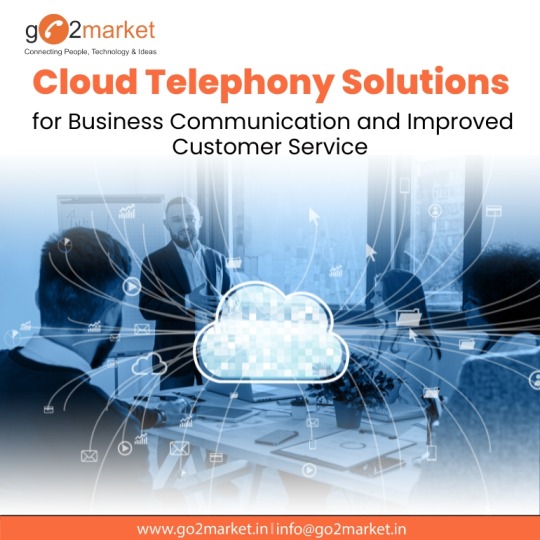#Cloud Telecommunication
Explore tagged Tumblr posts
Text
Cloud Telecommunication AI Market to Set a Phenomenal Growth in Near Future: Google LLC, AT&T, Cisco Systems

0 notes
Video
20231221_F0001: The museums in front of Kaknäs telecommunications tower by Wei-Feng Xue Via Flickr: - From a trip to Stockholm over #10YearsAgo. In front of the main telecommunications tower of Stockholm is a campus of many museums.
#Stockholm#Sweden#Kaknästornet#tower#telecommunication#antenna#water#clouds#cloudy#travelling#travel#sky#trees#museums#buildings#architecture#flickr
83 notes
·
View notes
Text

Transform the way your #healthcare team communicates!
With cloud #communication, you can boost staff efficiency, improve #patientcare, and stay connected with reliable, real-time solutions. 💻💉 Learn how #cloudtechnology can revolutionize healthcare communications: https://www.vitelglobal.com/healthcare-cloud-phone-services
#cloudcommunications#HealthcareSolutions#EfficientCare#VitelGlobal#health#HealthCareInnovation#BusinessPhoneSolutions#FutureOfHealthcare#technology#Telecommunications#voipsolutions#cloud#PBX#unifiedcommunications#CloudPBX#smallbusiness
7 notes
·
View notes
Text

Explore the evolving diversification of telephone communication in hospitality. Let’s take a closer look at how modern telephony solutions can help you communicate better in a remote working world. Learn More...
#cloud technology#unified communications#hotel pbx#hotel hospitality#ip telephony#phonesuite voiceware#hotel phone system#phonesuite pbx#hotel phone installation#voiceware by phonesuite#VoIP Protocol#VoIP#voip phones#voip phone#voip technology#voip minutes provider#voip phone system#cloud computing#cloud services#voip solutions#telecommunications#Call Booking#Hotel Technology#Hotel industry#Hospitality technology#Communications#Telephony#cloud telephony#telephonysolutions#phonesuite
9 notes
·
View notes
Text


5 notes
·
View notes
Text
Ericsson secures antenna agreement with Optus to boost 5G performance and network energy efficiency
Optus and Ericsson (NASDAQ: ERIC) today announced a strengthened partnership to deploy high-performance antennas designed to enhance the coverage, capacity, and energy efficiency of Optus’ 5G network. Press Release – Jun 13, 2025 – Under the agreement, Ericsson will deliver Ericsson Antenna System (EAS) solutions tailored to Optus’ operational needs, building on the companies’ long-standing…
0 notes
Text
The Future of Business Communication: Trends Shaping Cloud PBX Providers

Digital transformation is no longer a forward-looking ambition; it's a present-day imperative. For organizations across industries, innovation initiatives like cloud migration, automation, hybrid work, and data-driven decision-making reshape how business gets done. At the heart of these efforts lies a critical, often underappreciated enabler: telecom infrastructure.
A scalable, secure, and intelligently managed telecom environment is a support system and a strategic foundation that allows transformation to happen. And for CIOs tasked with leading digital change, aligning telecom strategy with broader innovation goals is essential to delivering meaningful, measurable progress.
This article explores telecom infrastructure's vital role in digital transformation and how CIOs can modernize their networks to support future-ready operations without compromising control, security, or budget. With the right telecom expense management partner, businesses can make smart telecom investments that align seamlessly with growth strategies and evolving technologies.
The Strategic Shift in CIO Priorities
Today's CIOs are not just IT gatekeepers but digital transformation leaders. Their role now intersects with revenue growth, customer experience, innovation, and operational agility. To meet these elevated expectations, CIOs must ensure that every component of the IT environment, including telecom, supports enterprise-wide goals.
Telecom infrastructure influences nearly every part of the digital stack. It impacts:
How cloud applications perform
How data flows between systems and users
How remote teams connect and collaborate
How reliably customers can reach the business
Legacy telecom setups, with their rigid configurations, slow provisioning cycles, and siloed billing structures, weren't built for this level of integration. To support transformation at scale, CIOs must reimagine telecom not as a cost center but as a key lever of enterprise agility.
Aligning Telecom with Cloud Migration Strategies
Most digital transformation roadmaps include aggressive adoption of cloud platforms—whether for application hosting, storage, communication, or analytics. But cloud environments demand high-performance, low-latency, and highly available network connections. If telecom strategy doesn't evolve in tandem, cloud ROI suffers.
Modernizing telecom to support cloud migration involves:
Prioritizing bandwidth upgrades and traffic management to ensure consistent performance across SaaS, IaaS, and PaaS platforms
Implementing SD-WAN solutions that allow dynamic routing, faster failover, and more resilient cloud access
Centralizing telecom oversight to reduce provisioning delays and shadow IT
A telecom management specialist helps CIOs navigate cloud-aligned telecom transformation by designing scalable network architectures, rationalizing vendor contracts, and ensuring vendors optimize bandwidth provisioning for multi-cloud and hybrid environments.
Supporting Hybrid Work Through Agile Connectivity
The hybrid workplace is here to stay, and supporting it requires more than issuing laptops and video conferencing accounts. Telecom infrastructure must accommodate on-site and remote users with seamless, secure connectivity, without creating unnecessary complexity or cost.
Telecom challenges in hybrid environments include:
Maintaining consistent voice and data quality across home networks, mobile devices, and office setups
Securing distributed endpoints without adding friction to user workflows
Managing telecom assets (mobile plans, VoIP lines, conferencing licenses) across locations
CIOs need visibility across the full telecom lifecycle to solve these issues, from procurement to decommissioning. That means having centralized tools for tracking inventory, analyzing usage, and adjusting service levels based on actual needs.
A communications lifecycle management advisor provides this level of lifecycle control. Their centralized platform enables agile telecom management that adapts to evolving work models, helping CIOs deliver high-performance experiences for every team member, regardless of location.
Driving Automation with Integrated Voice and Data Infrastructure
Automation is a cornerstone of digital transformation. From streamlining customer service with chatbots to automating internal processes like billing or onboarding, success depends on a tightly integrated data environment, including telecom systems.
Modern telecom tools can now feed data into automation engines, trigger workflows based on call patterns, or even enhance AI-powered tools with real-time voice analytics. However, to unlock this potential, CIOs must integrate PBX, collaboration platforms, and call management systems into the broader IT ecosystem, which requires:
Cloud-native telecom platforms that support open APIs and flexible integrations
Advanced call analytics and transcription tools that provide usable data for automation triggers
Unified communication strategies that link voice, video, messaging, and CRM systems
A communications lifecycle management advisor partners with organizations to identify automation-ready telecom solutions and build integration roadmaps that align with automation goals, whether internal or customer-facing.
Controlling Costs Without Stalling Innovation
CIOs are under pressure to deliver innovation, but often without a corresponding increase in budget. This disconnect makes cost control a strategic priority. However, managing telecom expenses in a growing, decentralized environment is notoriously difficult. Key areas of cost leakage include:
Unused or duplicate services
Overprovisioned bandwidth or mobile plans
Inconsistent vendor pricing across departments or regions
Manual invoice reconciliation and a lack of auditing
CIOs need visibility, control, and optimization to enable transformation without runaway spending. That's where a telecom expense management partner delivers measurable impact. Their platform helps clients:
Audit invoices for errors and recover lost funds
Benchmark vendor pricing to ensure competitive rates
Rationalize services based on real-time usage data
Consolidate and renegotiate contracts across locations
By turning telecom from a reactive expense into a proactive asset, CIOs free up budget to reinvest in forward-looking initiatives.
Building an Adaptable Network for What's Next
One of the most important goals of digital transformation is future readiness. That means building a telecom strategy that can support technologies not yet widely used—like IoT deployments, edge computing, 5G connectivity, or AI-driven communications.
Future-ready telecom environments share a few key characteristics:
Flexibility: The ability to scale services up or down without renegotiating contracts or adding infrastructure
Vendor agility: The freedom to adopt best-fit solutions without being locked into legacy providers
Data visibility: Access to performance and usage metrics that drive continuous improvement
Security and compliance: Built-in safeguards for an increasingly complex regulatory landscape
zLinq helps CIOs future-proof their networks by providing access to the latest telecom technologies, ensuring systems are agile, compliant, and ready to support emerging digital use cases.
The Role of Lifecycle and Vendor Management
You don't build a well-aligned telecom strategy overnight; it's built over time, through consistent management and proactive decision-making. For CIOs, this means having the tools and partners in place to manage every phase of the telecom lifecycle:
Planning and procurement
Implementation and integration
Optimization and performance monitoring
Contract management and renewals
Decommissioning and recycling
It also means holding vendors accountable, not just on pricing, but on performance, security, and service delivery.
A telecom management specialist provides comprehensive lifecycle and vendor management support, acting as a strategic partner working alongside CIOs to ensure telecom infrastructure evolves with organizational priorities.
Future-Ready Starts with Smart Telecom Strategy
As CIOs lead the charge toward digital transformation, they must ensure that every part of the IT environment is aligned with innovation goals, including telecom. A modern, scalable, data-driven telecom strategy supports cloud migration, hybrid work, automation, and emerging technologies while controlling costs.That alignment is only possible with the proper support and expertise that bridges the gap between technical needs and strategic execution. With a strategic partner like zLinq, CIOs gain the visibility, tools, and guidance they need to modernize telecom infrastructure and align it with long-term business objectives. From vendor management and cost optimization to lifecycle support and integration strategy, zLinq helps organizations build a network that not only supports the future but also helps create it.
0 notes
Text
Why Price Telecommunications is the Ideal Partner for Scalable VoIP Solutions

VoIP Phone Systems Scalability for Growing Business
What is Scalability in VoIP and Why Does It Matter?
VoIP Phone System scalability is more than just a buzzword—it’s a key component in ensuring your business VoIP phone system is equipped to scale as your business grows.
Price Telecommunications provides scalable VoIP phone systems that scale effortlessly, allowing you to increase or reduce call capacity based on your communication needs. Whether you’re hiring a large new team or shifting to a smaller workforce, our VoIP phone systems can adapt without expensive phone upgrades or call system downtimes.
By choosing Price Telecommunications, you ensure that your VoIP phone system is scalable and ready for whatever changes come your way, giving your business the call system flexibility it needs.
VoIP Call System Flexibility for Changing Business Needs
Adding or Removing Users with Scalable VoIP Phone Systems
At Price Telecommunications, we believe your VoIP phone and call communication system should be as flexible as your business needs. With our scalable VoIP phone service, you can quickly add or remove call users through an intuitive online platform. There’s no need to wait for network technicians or deal with hardware installations because the VoIP phone system is managed remotely, allowing you to add phones to your scalable VoIP phone system to adapt to staffing changes in real-time.
Our flexible VoIP phone system means you can adjust user numbers instantly, making it perfect for businesses that experience seasonal fluctuations or rapid growth. Price Telecommunications makes managing your phone and call communication infrastructure simple and efficient.
Scalable VoIP Phone Systems
The Role of Cloud-Based VoIP in Scalability
A cloud-based VoIP phone system is essential for businesses looking to scale quickly, and Price Telecommunications offers one of the most reliable scalable VoIP cloud solutions available. By hosting your VoIP phone system in the cloud, you can easily manage multiple locations, remote employees, and growing teams without needing expensive physical infrastructure.
With Price Telecommunications’ cloud VoIP phone systems, you benefit from automatic updates, secure backups, and system redundancy. This ensures your VoIP phone system is future-proof and enhances your business’s overall call communication capabilities as you grow.
VoIP Phone System and Planning for the Future
Anticipating Your Communication Needs with Scalable VoIP
A VoIP phone system that is scalable is essential in planning for future growth. VoIP phone systems are built to avoid costly and time-consuming phone system changes.
We help you anticipate your long-term VoIP phone and call communication needs at Price Telecommunications. VoIP phone systems can scale with your business; whether you’re looking to expand your workforce, open new offices, or implement advanced VoIP phone features like analytics and international calling, we provide a scalable VoIP phone system tailored to meet those demands.
Our VoIP team helps to ensure that your VoIP phone system grows in sync with your organization, keeping call communication smooth and VoIP phone systems reliable as you expand.
Contact Price Telecommunications for expert scalable VoIP phone systems for your business or family office.
Price Telecommunications, Inc.
3237 S Cherokee Lane Building 1100 Suite 1120 Woodstock GA 30188
Office: (770) 977–9999
Facebook
LinkedIn
X
#telecommunications company#telecom services#fiber optic internet#business phone systems#VoIP solutions#broadband providers#wireless communication#network infrastructure#telecom consulting#cloud communications
0 notes
Text

Elevate service with CX quality assurance
Customer experience (CX) quality assurance is all about ensuring every interaction with your customers leaves them happy and eager to come back. It’s not just about solving problems—it’s about creating memorable experiences that drive loyalty and trust. By reviewing every touchpoint, CX quality assurance helps businesses improve service, boost performance, and ultimately grow revenue.
Traditional quality control, on the other hand, focuses on the production side of things. It’s about ensuring that products or services meet specific standards through inspections and well-defined processes. According to ISO 9000, it’s a key part of quality management, ensuring everything works as intended before reaching the customer.
Unlock the power of quality assurance for exceptional service
Maximizing customer satisfaction is easier with the right quality assurance approach and CCaaS configuration. Our expert insights help you turn feedback into actionable improvements that drive growth. By focusing on every interaction, we enhance customer experiences and boost loyalty.
With a streamlined process for gathering and analyzing data, we ensure smooth integration into your existing systems. This enables more personalized service, informed decision-making, and better efficiency. By prioritizing simplicity, security, and scalability, we guide you to the right CX strategy for long-term success.
#telecommunications solutions#technology company#Business consultant#Information Technology#CX cloud migration#CCaas configuration
0 notes
Text
5G System Integration Market Report: Insights, Trends, and Forecast 2022–2030

5G System Integration Market Report – Straits Research
Market Overview
The global 5G System Integration Market was valued at USD 7.76 Billion in 2021 and is projected to grow from USD XX Billion in 2022 to USD 67.16 Billion by 2030, growing at a robust CAGR of 27.1% during the forecast period (2022–2030). The market encompasses the integration of advanced technologies, including 5G networks, IoT devices, cloud computing, and edge computing, into existing infrastructures to enable high-speed communication and seamless connectivity. 5G system integration is essential for businesses across various industries to unlock the full potential of 5G technology, providing faster speeds, lower latency, and more reliable connections. With the growing demand for high-speed, ultra-reliable, and low-latency communications, the 5G system integration market is expected to experience significant growth.
Request a Free Sample (Free Executive Summary at Full Report Starting from USD 1850): https://straitsresearch.com/report/5g-system-integration-market/request-sample
5G System Integration Market Categorization
The 5G System Integration market is segmented in multiple ways, each targeting specific services, industries, and applications that benefit from 5G technology.
1. Services Outlook:
The services provided in 5G system integration can be divided into three main categories:
Consulting: Consulting services are crucial for businesses looking to adopt and integrate 5G technology into their operations. Consultants offer strategic advice on deployment strategies, cost management, and technology selection.
Infrastructure Integration: This involves the integration of 5G infrastructure, such as base stations, towers, and small cells, with existing network systems. This integration ensures the seamless functioning of 5G networks alongside legacy systems.
Application Integration: This service focuses on integrating 5G technology with applications across different sectors, ensuring that businesses can optimize their operations and communication systems by leveraging high-speed data transmission and low latency.
2. Vertical Outlook:
The market for 5G system integration is further segmented by industry verticals, as different sectors adopt 5G technology to enhance their operations:
Manufacturing: The adoption of 5G in manufacturing enables smart factories with automation, robotics, and real-time analytics, improving productivity and efficiency.
Energy & Utility: 5G technology enables real-time monitoring of energy grids, smart meters, and power distribution systems, improving operational efficiency and minimizing downtime.
Media & Entertainment: 5G enables high-quality streaming, virtual reality (VR), and augmented reality (AR) experiences, transforming the entertainment industry and providing new opportunities for content creators.
IT & Telecom: Telecom companies are leveraging 5G technology to upgrade their networks and provide high-speed internet services to customers, while the IT sector uses 5G to support large-scale cloud computing and data processing.
Transportation & Logistics: 5G supports the growth of autonomous vehicles, smart logistics, and real-time tracking, improving operational efficiency and reducing costs in the transportation and logistics industry.
BFSI (Banking, Financial Services, and Insurance): In the BFSI sector, 5G integration allows for secure, real-time transactions, mobile banking services, and enhanced customer experiences.
Healthcare: 5G’s low latency enables telemedicine, remote surgeries, and patient monitoring systems, helping healthcare providers improve patient care and operational efficiency.
Retail: Retailers use 5G technology to enhance customer experiences through augmented reality, personalized shopping experiences, and real-time inventory management.
Others: This category includes sectors such as education, government, and agriculture that are also adopting 5G technology for improved communication, data analysis, and operational efficiency.
3. Application Outlook:
The diverse applications of 5G technology span several fields, each providing unique benefits for different industries:
Smart City: 5G enables the development of smart city applications such as intelligent traffic systems, smart meters, and public safety systems, improving urban living.
Collaborative Robots / Cloud Robots: The integration of 5G with robotics allows for the deployment of collaborative robots in manufacturing and other industries, improving automation and efficiency.
Industrial Sensors: 5G facilitates the use of industrial sensors for real-time monitoring and data collection, enabling predictive maintenance and improving operations in industries like manufacturing and energy.
Logistics & Inventory Monitoring: With 5G, companies can track inventory in real-time, improve logistics efficiency, and enable faster delivery times, reducing operational costs.
Wireless Industry Camera: 5G enables high-definition video streaming from cameras used in industries like surveillance, security, and media, ensuring smooth, high-quality streaming.
Drone: Drones equipped with 5G can transmit high-definition video and data in real time, enabling uses in agriculture, delivery, and infrastructure inspection.
Home and Office Broadband: 5G enables high-speed internet access for both residential and commercial properties, enhancing broadband services for customers.
Vehicle-to-everything (V2X): V2X technology powered by 5G allows for communication between vehicles, infrastructure, and pedestrians, enabling safer, more efficient transportation systems.
Gaming and Mobile Media: 5G enhances the gaming experience by providing low-latency, high-speed connections for mobile games and media streaming.
Remote Patient & Diagnosis Management: 5G enables remote healthcare services, allowing for faster diagnosis, patient monitoring, and telemedicine applications.
Intelligent Power Distribution Systems: 5G enhances the management of power grids by providing real-time data, improving grid stability and reducing energy losses.
P2P Transfers / mCommerce: 5G facilitates faster peer-to-peer (P2P) payments and mobile commerce, enhancing the customer experience in the financial services industry.
4. Geographic Overview:
The 5G System Integration Market is witnessing dynamic growth across the globe. Key regions and their dominant countries are:
North America: The U.S. leads the North American market with the largest adoption of 5G technology, driven by the presence of major telecom players, technological advancements, and high investments in 5G infrastructure.
Europe: The European market is expanding, with the U.K., Germany, and France playing a significant role in adopting 5G systems, especially in manufacturing, healthcare, and transportation.
Asia Pacific: Asia Pacific is expected to witness the highest growth during the forecast period, with countries like China, Japan, and South Korea leading the 5G adoption race. The region’s strong focus on technological innovation and infrastructure development fuels market growth.
Latin America: Latin America is catching up with other regions in adopting 5G technology, particularly in countries like Brazil and Mexico. These countries are focusing on 5G infrastructure deployment and increasing connectivity in urban and rural areas.Market Segmentation with Insights-Driven Strategy Guide: https://straitsresearch.com/report/5g-system-integration-market/segmentation
Top Players in the 5G System Integration Market
The 5G System Integration Market features several industry leaders who are pivotal in the growth and innovation of 5G technology:
Accenture Inc.
Cisco Systems, Inc.
Huawei Technologies Co., Ltd.
Infosys Limited
Tata Consultancy Services Limited
Wipro Limited
Radisys Corporation
IBM Corporation
HPE (Hewlett Packard Enterprise)
Oracle Corporation
HCL Technologies Limited
ALTRAN
AMDOCS
CA Technologies
Hansen Technologies
Samsung Electronics Co., Ltd.
Ericsson
Keysight Technologies
ECI Telecom
These companies provide integrated solutions and services for the successful implementation and deployment of 5G systems, contributing to the rapid growth of the 5G ecosystem.
Key Unit Economics for Businesses and Startups
For businesses and startups, understanding the unit economics of 5G system integration is essential. Key metrics include:
Cost of Integration: The total investment required for adopting 5G infrastructure, including hardware, software, and consulting services.
Return on Investment (ROI): The anticipated financial returns from deploying 5G technology, which could include cost savings, enhanced operational efficiency, and new revenue streams.
Customer Acquisition and Retention: 5G enhances customer experiences, leading to higher retention rates and attracting new customers through innovative services.
Startups looking to integrate 5G technology should focus on scalable solutions and consider cloud-based integration services to reduce upfront costs.
Buy Full Report (Exclusive Insights with In-Depth Data Supplement): https://straitsresearch.com/buy-now/5g-system-integration-market
5G System Integration Market Operational Factors
Several operational factors influence the 5G system integration market, including:
Technology Advancements: Continuous developments in 5G, IoT, and edge computing technologies are driving the market forward.
Regulatory Challenges: Countries are implementing policies and regulations related to spectrum allocation, network sharing, and data security, affecting 5G adoption.
Deployment Costs: The high cost of infrastructure and integration services remains a barrier for some businesses, especially startups and small enterprises.Table of Contents for the 5G System Integration Market Report: https://straitsresearch.com/report/5g-system-integration-market/toc
About Straits Research
Straits Research is a leading provider of market research and intelligence services. With a focus on high-quality research, analytics, and advisory, our team offers actionable insights tailored to clients’ strategic needs.
Contact Us Email: [email protected] Address: 825 3rd Avenue, New York, NY, USA, 10022 Tel: UK: +44 203 695 0070, USA: +1 646 905 0080
#5G System Integration#5G Market Growth#5G Integration Services#Telecommunications#IoT Integration#Smart Cities#Mobile Technology#Cloud Computing#Infrastructure Integration#Market Forecast#Industrial IoT#Autonomous Vehicles#5G Applications#Consulting Services#Telecom Industry#Market Analysis#5G Adoption#Global 5G Trends#Digital Transformation#Technology Integration#Straits Research
0 notes
Text
Cloud Telephony Solutions for Business Communication and Improved Customer Service
Cloud telephony solutions help businesses manage their communication more securely and efficiently and their business processes more effectively. Connect with go2market to learn more about how cloud telephony can improve the quality of your business communications and customer service.

#go2market#go2marketindia#cloud telephony service#cloudscape#cloud communications#Cloud Telephony Solutions#telecommunication
0 notes
Text
“Blue Sky: Sentinel”
© EricBrazier.com
#antennas#blue sky#cell tower#clouds#cylinder#cylindrical#dawn#golden hour#ladder#magic hour#sentinels#telecommunications#tower
1 note
·
View note
Text

In this article provides actionable tips for enhancing hotel guest communication using the latest advancements in hotel phone systems and cloud VoIP technology, ensuring that hoteliers stay ahead of the curve in guest satisfaction. Learn More...
#hotel phone system#pms integration#voip#hotel pbx#cloud technology#hotel hospitality#ip telephony#phonesuite pbx#cloud voip#modern technology#unified communications#hotel industry#voip phone system#hotel phone installation#system providers#PBX#communication#telecommunication#phonesuite#telecommunications
3 notes
·
View notes
Text
🌐 The Impact of Cloud Computing on Business Scalability and Innovation
Cloud computing has revolutionized the way businesses operate, providing scalable, on-demand access to IT resources without the need for costly hardware investments. With cloud solutions, companies can deploy applications, store and analyze data, and enhance collaboration in a secure, flexible environment. This article explores the transformative power of cloud computing, its benefits for…
#AI Integration#Business Continuity#Cloud Computing#Data security#Edge computing#IoT#SaaS#Scalability#Telecommunications
0 notes
Text

En fouillant le disque dur
1 note
·
View note
Text
GCI selects Ericsson to deploy and operate new 5G Core network
GCI Communication Corp partners with Ericsson for core network Build and Operate, deploying 5G Core as part of the Ericsson dual-mode 5G Core solution to support the operator’s ongoing transformation. Ericsson will assume responsibility for core network operations across all network generations, leveraging AI to enhance customer experience, freeing up GCI resources for strategic…
#5G#AI#AI Cloud#AI infrastructure#Artificial Intelligence#Cloud#Infrastructure#Technology#Telecommunications
0 notes